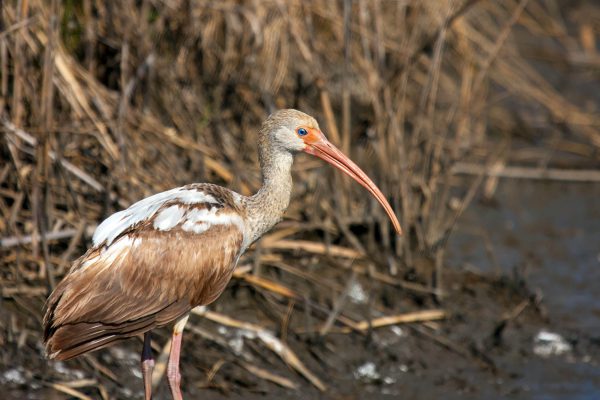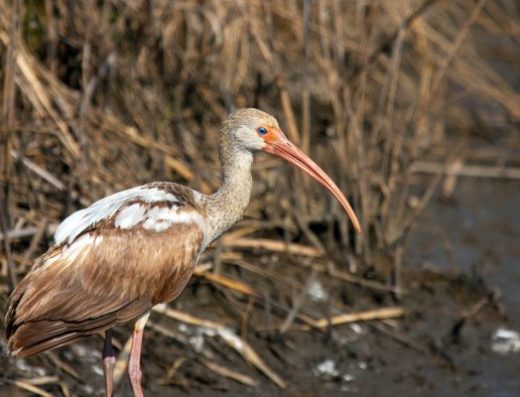
Wetlands part of Texas Chenier Plain, westernmost geologic delta of the Mississippi River.
Follow a nature trail near headquarters to get an up-close look at this marsh area’s residents. This tract along the Great Texas Coastal Birding Trail hosts brown pelicans, sea turtles, muskrat, nutria, armadillo, rice rat, bobcat, river otters, swamp rabbits, alligators, etc. Also look for least bitterns, roseate spoonbills, purple gallinule and waterfowl.
Dates Open:
Fishing, wildlife viewing and other non-consumptive uses are available seasonally as provided by information in the TPWD Public Hunting Lands Permit Map Booklet. These activities are limited during scheduled public hunts for September teal and regular waterfowl, feral hog and alligator seasons.
Description
In 1963, the WMA was named in honor of John David Murphree, a Texas Game Warden who was murdered by a duck poacher in Jasper County.
The original 8,200 acres of land for the wildlife management area was purchased in 1957 from the William Perry Herring McFaddin heirs. The McFaddin family owned thousands of acres of land of which some was received for service in the Texas army during the Texas Revolution. William M. McFaddin, his son William Perry Herring McFaddin and family were pioneer settlers in the Beaumont area, ranching, rice farming, commercial, fur trapping, and searching for oil.
The J. D. Murphree WMA is a 24,498 acre tract of fresh, intermediate and brackish water coastal marsh on the upper coast of Texas. The original 8,312 acres of the Big Hill Unit were acquired in 1958 using funds generated by waterfowl stamp and hunting license sales. The Lost Lake Unit was acquired in 1983 through mitigation. An additional 11,231.23-acre tract was added to the Area in August 1997, in a trade of Sheldon WMA lands for lands in Sea Rim State Park. This acreage was added to the Lost Lake Unit and re-designated as the Salt Bayou Unit (15,595 acres). The Area represents the coastal marshes of the Texas Chenier Plain and is managed as wetland habitat with a special emphasis on migratory waterfowl habitat. The Hillebrandt Unit (591 acres) was added to the Area as mitigation in 1987. These wetlands are part of the Texas Chenier Plain, the westernmost geologic delta of the Mississippi River.
The WMA headquarters is on the south side of Highway 73 at the intersection of Jade Avenue in Port Arthur.
Ecological and Cultural Characteristics
Habitat Types: The WMA is highly diverse in coastal wetland communities. Vegetative communities found within the area are indicative of freshwater, intermediate, brackish and to small extent saline wetlands. The freshwater wetlands also support an expanding association of exotic and noxious wetland plants. Plants typically found in freshwater wetlands include cattails, California bulrush, Jamaican sawgrass, lotus, and arrowheads (Sagittaria species). Marshes with a little salt influence support plants such as seashore paspalum, cordgrass banana waterlily and spikerushes. Cordgrass, salt grass, widgeongrass and dwarf spike rush are plants indicative of brackish marshes, where the influence of salt water is higher, while oystergrass is the dominant plant of salt marshes near Sabine Lake.
Breeding/Nursery Area: Wildlife diversity within the Area is high. The Area is a key nesting and brooding area for Mottled Ducks, with an increasing amount of nesting by Fulvous and Black-bellied Whistling ducks, particularly since the late 1980s. Several species of secretive marsh birds, shorebirds, and wading birds nest and raise young within the wildlife management area.
Animal Communities: Besides the migratory and nesting waterfowl that make extensive use of the Area, many species of mammals inhabit the wetlands. They include the muskrat, nutria, swamp rabbit, eastern cottontail, raccoon, river otter, coyote, mink, opossum, armadillo, striped skunk, rice rat, white-footed mouse, bobcat, and cotton rat.
The American alligator is the single most important reptile and predator on the Area with a population density likely not exceeded in any other site in Texas. Alligators were commercially harvested in 1984 and have been harvested in subsequent years by special drawn permit public hunts. Pig frogs and other amphibians are not uncommon, especially in the Big Hill and Hillebrandt units.
Freshwater and saltwater fishes common to the Texas coast are found in the Area. Among the freshwater species commonly found are largemouth bass and sunfish, while speckled trout, redfish and flounder are seasonally abundant in tidal waters of the management area.
Migratory Species: The area is the center of the small but principle stopover and staging area for much of the waterfowl of the Central Flyway and provides high quality winter waterfowl habitat. The area supports a large number of gadwall, blue-wing and green-wing teal in the winter. A significant portion of the Central Flyway canvasback population will spend several weeks in winter on the management area putting on weight for the migration north to their breeding grounds.
Rare/Endangered Species: Threatened or endangered species that may occur within Jefferson County are:
Piping Plover (Charadrius melodus)
Green Sea Turtle (Chelonia mydas)
Hawksbill Sea Turtle (Eretmochelys imbricate)
Ridley Sea Turtle (Lepidochelys kempii)
Loggerhead Sea Turtle (Caretta caretta)
Louisiana Black Bear (Ursus americanus luteolus)
Archaeological and Cultural Significance: The Chenier Plain marshes of Texas were inhabited by a primitive tribe of Indians called Atakapa. Unaltered shorelines along natural lakes, ponds and bayous are high probability areas for containing prehistoric archeological deposits. Several Indian sites are recorded within the WMA.
Current and Potential Use of the Site
Existing or Potential Educational Use: Educational field trips and wetlands workshops can be scheduled for students, landowners, public users and environmental professionals.
Recreational Use: The Area traditionally conducts half-day public waterfowl hunts three days a week in each Unit of the WMA, on a first come/first-served basis during the regular waterfowl season and each day of the September Teal season. Public hunts for alligators are conducted by special permit during the September alligator season. Youth only and youth/adult public hunts for waterfowl and alligators are scheduled periodically for each Unit of the WMA. Fishing is a popular public use benefit of the management area. Public access to most of the area is restricted to boats due to the lakes, bayous and marshes associated with this property.
Very good potential for bird watching exists on the WMA, but limited walk-in access impacts the amount of bird watching activity within the WMA.
Commercial Use: Commercial fishing is not allowed on the WMA. Pipelines and mineral development for oil and gas are common to all units of the Area.
Management Status
Management Status: Long term management is focused primarily towards winter waterfowl habitat. Additional management activities are to provide breeding, nesting, and brood-rearing habitat for mottled ducks through water level manipulation and vegetation management. Wetland restoration activities are conducted to improve the conditions of existing marsh and return marsh habitat to areas in which it was lost through erosion.
Since the 1930s the marshes in and around what is now the Salt Bayou Unit of the J. D. Murphree WMA are being lost at a rapid rate. In response, a multi-agency stakeholder group formed in 2000 to identify the major causes of loss and find ways to stop or reverse the trend. The group developed the Salt Bayou Watershed Restoration Plan to provide a watershed scale framework for management of these coastal wetlands. The goal of the group is to restore marsh that has been lost or is degrading to a self-sustaining condition that will benefit wildlife and fishery resources and their users well into the future. For additional information about the plan, contact Mike Rezsutek at 409-736-2551 ext. 30 or michael.rezsutek@tpwd.texas.gov.
Existing Monitoring Activities: Past research on the WMA includes a long history of waterfowl banding activities in the ’60s and ’70s, collection of alligator census data, and meticulous collection of data from waterfowl through public hunt exit interviews. Vegetation baseline data collected within the Units has been collected to track wetland plant succession and diversity.
Continuous data collected on the WMA on alligator nesting census lines and alligator night counts has helped to justify management of alligators statewide in Texas and remove the American alligator from the Endangered Species list in 1983. Water levels are monitored monthly on a continuing basis within the leveed impoundments found within the WMA to enhance annual plant production and seasonal water needs of migratory waterfowl. Mottled ducks have been banded annually since 1998, and several university and staff conduct on-going research projects related to wetlands and wildlife.
Please note:
There aren’t any restroom facilities.
Bring your own drinking water.
Insect repellant is recommended for mosquitoes.
High heat and humidity during the summer months should be considered when planning a trip.
A wildlife viewing platform in compartment one of the Big Hill Unit is available.
A boat designed to travel in shallow water and powered by a moderate outboard engine capable of a minimum of 12 miles of daily travel range is recommended for access to the WMA. Note that weather conditions can be highly variable in this coastal environment and that all marine advisories should be heeded.
Photo Courtesy Visit Port Arthur Texas https://visitportarthurtx.com/

